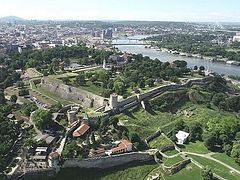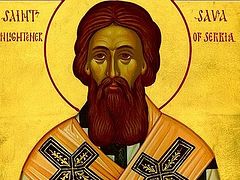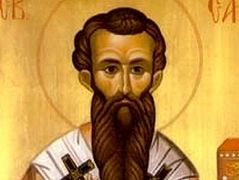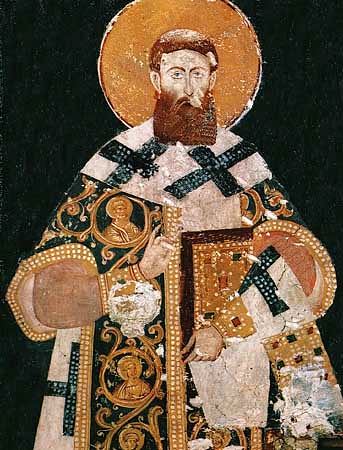 In 1198 or 1199, the Novgorod pilgrim Dobrynya Yadreykovich (future Archbishop Anthony), while providing a detailed description of the holy sites and monuments of Constantinople, mentioned a noteworthy detail that clearly captivated his imagination. Talking about the monastery of the Virgin Evergetis, he noted, among other things, “And here lives the monk Sava, the son of the Serbian prince.” The voluntary acceptance of monastic tonsure by a representative of the ruling house, renouncing the “sweetness of this world” at a young age, was, in the eyes of the Russian pilgrim, an event so extraordinary that the author deemed it appropriate to inform his compatriots alongside stories of the most famous shrines and curiosities of the capital of the Orthodox world.
In 1198 or 1199, the Novgorod pilgrim Dobrynya Yadreykovich (future Archbishop Anthony), while providing a detailed description of the holy sites and monuments of Constantinople, mentioned a noteworthy detail that clearly captivated his imagination. Talking about the monastery of the Virgin Evergetis, he noted, among other things, “And here lives the monk Sava, the son of the Serbian prince.” The voluntary acceptance of monastic tonsure by a representative of the ruling house, renouncing the “sweetness of this world” at a young age, was, in the eyes of the Russian pilgrim, an event so extraordinary that the author deemed it appropriate to inform his compatriots alongside stories of the most famous shrines and curiosities of the capital of the Orthodox world.
Dobrynya had evidently not been on Mount Athos before this, and even later in Novgorod, as he worked on composing his pilgrimage, he did not hear the accounts of Russian holy men about Sava; otherwise, he would undoubtedly have added several colorful details to the mention of him. By that time, despite his youth (he was about 24–25 years old), Sava was already a living legend on Mount Athos, and he was particularly memorable to Russian monks here.
Arriving on Mount Athos, this unique medieval international monastic republic, in the autumn of 1191, was younger son of the Serbian Grand Župan1 Stefan Nemanja—sixteen-year-old Rastimir (although, due to his youth, he was also diminutively called Rastko). His decision to escape worldly temptations and embrace the life of a recluse was influenced directly by conversations with a Russian monk who had come from Athos, along with other monks, to his father’s court seeking alms. Knowing that his passionate resolve would not find sympathy with his parents, Rastko asked his father for permission to go on an extended hunting trip to the mountainous forests, but instead, set out with the monks to Athos. The pious deception worked perfectly; the youth bought time, and the pursuit he anticipated did not catch up with him on the way. He safely reached the Russian Panteleimon Monastery with his companions, which at that time was located not by the sea, as it is now, but about an hour’s walk from the modern large coastal monastery, on a gentle mountain slope. Today, it is known as the Skete of Old Russikon, and little remains of its ancient structures. An illustration of what the Russian monastery on Athos looked like in the Middle Ages is provided by the drawing of the pilgrim Vasily Grigorovich-Barsky, who visited in 1744 (considering that the depicted cathedral was built in 1628 in traditional forms for the Holy Mountain). The monastery was an ideal fit for the young Slavic monk. Here, they spoke in a language he understood (most likely, there were also Serbian monks in the brotherhood), and at the same time, there was an opportunity to enhance his knowledge of conversational Greek, which was used by the multilingual monastic community of the Holy Mountain.
But Rastko Nemanjić had barely donned the black robes when he was caught up by a group sent by his father. Both the fugitive and his pursuers wanted to settle the matter peacefully, but Rastko wanted to stay and become a monk, while the soldiers were commissioned to bring the wayward prince back under his father’s roof at all costs, even if it meant putting him in chains. The young man had to resort to deception again, verbally agreeing to return. A feast was organized in honor of the arrivals, at which the young prince himself served the guests. Then (it was a Saturday), the Sunday Vigil service began. Tired from the journey and relaxed from the feast, the soldiers could not endure the lengthy worship service and fell asleep right in the church, on the stasidia (unlike in Russia, in the Balkans, worshippers stand and sit at the service alternately). Rastko took advantage of this and went with the abbot to a small church at the top of the tower (a fortress tower-donjon is an indispensable attribute of ancient Athonite monasteries), where the tonsure ceremony took place. When the soldiers woke up before dawn and rushed to search for the prince throughout the monastery, generously distributing slaps to the monks, it was already too late. Rastko Nemanjić no longer existed; in his place appeared the monk Sava, who took this name in honor of one of the founders of Palestinian monasticism—St. Sava the Sanctified (5th–6th century). The newly tonsured monk dropped a symbolic gift from the tower to the military leader, explaining everything without words—his secular clothing and shorn locks of long hair. This truly theatrical scene was later favored by icon painters, both Serbian (icon painter Georgije Mitrofanović in the frescoes of Hilandar Monastery on Athos, 1621), and Russian (illustrators of the Illustrated Chronicle of the second half of the 16th century). In Old Russikon, visitors are still shown the place where all this happened, albeit with a significant topographical inaccuracy: The ancient tower, which stood to the east of the cathedral, no longer exists, and its role for tourists and pilgrims is played by the surviving southeast tower.
The messengers, cursing their misfortune and the heartlessness of the young prince, returned home. Fortunately, they did not face any punishment. The Grand Župan reconciled with the independent action of his younger son. As a gesture of forgiveness, lavish gifts were sent to the monastery that had welcomed Sava. The fame of the young monk quickly spread throughout Mount Athos—his life choice was so unusual, reminiscent of the similar act of the Indian prince Ioasaph, the hero of the popular medieval Christian tale, “The Story of Barlaam and Ioasaph.”
Sava did not stay long in the Russian monastery, probably just enough to acclimate to the monastic routine and sufficiently grasp conversational Greek. In the following year, 1192, he moved to the Greek Vatopedi on the northeastern coast of the peninsula—one of the oldest and wealthiest monasteries on Athos. However, the young monk maintained good relations with his first Holy Mountain abode. In 1199, when the newly established Serbian Hilandar Monastery on Athos held the burial of his father (Stefan Nemanja, who in 1196 abdicated the throne, took monastic vows with the name Simeon, and a year later relocated to Athos), over the deceased’s grave, they sang, “First the Greeks, then the Iberians [Georgians], then the Russians, and after the Russians, the Bulgarians.”
Close ties between the Russian Panteleimon Monastery and the Serbs, as well as Serbia, persisted into the future. Significantly, in the second half of the thirteenth century, when the influx of monks to Athos from the Mongol-ravaged Rus’ dwindled, the monastery became Serbian (and remained so until at least the sixteenth century), and its benefactors for almost two hundred years were the rulers of Serbia.
Of course, Sava’s interest in Russian monasticism and Russian scribes on Athos and in Constantinople (where he had the opportunity to meet them during his travels on behalf of Vatopedi and the revived Hilandar in 1198 and 1199) was primarily driven not by sentimental feelings towards the place of his tonsure, even though it was a memorable and vivid event. As the son of the ruler who established Serbia as an independent state, Sava saw himself as continuing his father’s work on the ecclesiastical front. Long before, in 1219, he and his brother—King Stefan the First-Crowned—succeeded in creating the autocephalous Serbian Church, he devoted much attention to Church organization, rituals, and liturgical practices. During Sava’s youth, Rus’ was the only Orthodox Slavic country where there existed an independent church organization with a stable tradition of official worship in the Slavic language (the Bulgarians, who only liberated themselves from Byzantine domination in the 1180s, differed little in this regard from the Serbs). The Russian tradition was one of the important sources of the revival of Slavic literary culture in the Balkans during St. Sava’s time, and this is particularly noticeable in the case of Serbian monuments.
The imprint of close contacts with Russian monasticism is found in the largest translation associated with the name of the saint—the so-called Svetosavskaya (or Serbian) Nomocanon—a collection of canonical and ecclesiastical-legal rules with explanations by prominent Byzantine canonists and lawyers of the twelfth century. Even in the nineteenth century, researchers noticed the presence of a significant number of words in the language of this edition that were atypical for South Slavic languages but quite common in Old Russian. In the older copy of this Nomocanon—Ilovica, features of East Slavic orthography can be traced. Some specialists see evidence in this translation of the direct participation of Russian scribes living on Mt. Athos at that time, while others consider it a consequence of the high prestige of the Russian variant of the Church Slavonic language among the South Slavs in the late twelfth to the early thirteenth centuries, with the simultaneous use of East Slavic lexicon by Serbian translators. In recent times, orthographic Russisms have been seen as reflecting Russian-Serbian contacts after Sava’s death, especially given the participation of a Novgorod scribe in the correspondence of the Ilovica copy in 1262. However, in any case and under any interpretation, these facts testify to the close ties of the Serbian saint with Russian monasticism.
These contacts had their reverse side. Texts written by Savva or translated by him, either on his initiative or not, quite early (though not always during his lifetime) became part of Russian literature. In the Russian copies of the main monastic book—the Psalter—beginning from the fourteenth century (earlier examples are unknown, possibly not preserved), a peculiar preface is quite commonly placed: “Guidelines on How to Use the Psalter,” in which its compiler identifies himself as Monk Savva (sometimes the name is replaced or omitted, but most copies contain this variant); in the Serbian tradition, it is much less common and appears in later copies (not earlier than the sixteenth century).
Serbian scholar V. Chorovich established an extraordinary closeness of this text to the introductory chapter of the Hilandar Typicon; later, this was confirmed by the Bulgarian philologist Bonyu Angelov in a large report. Quite recently, it was discovered that the Hilandar Typicon was known in Russia in its entirety. In 1998, Bulgarian researcher Klementina Ivanova found in the collection of the Belokrinitsa Old Believer Metropolis, stored in the manuscript department of the Bulgarian Academy of Sciences in St. Petersburg, a Russian copy of the sixteenth century monument, in the title of which the text is attributed to St. Savva the Sanctified, in whose honor the future Serbian archbishop chose his monastic name.
The relatively late dating of Russian copies of the works by St. Savva does not mean that these literary monuments reached Russia in the fourteenth and sixteenth centuries accordingly. In the Russo-Serbian cultural connections from the second half of the thirteenth century, a deep decline occurred due to the Mongol conquest, and their revival began only from the late fourteenth century. However, research shows that at this new stage, old South Slavic texts (dating back to the turn of the thirteenth to fourteenth centuries) did not interest Russian scribes, whose attention was focused on translations made by Bulgarians and Serbs on Mount Athos in the fourteenth century. Therefore, Savva’s works and translations could have reached Russia no later than the second half of the thirteenth century.
This is confirmed by the history of the appearance of the Svatoslavsky Rudder in Russia. The book was sent to Kiev in 1262 at the request of Metropolitan Kirill of Bulgaria by Despot2 Yakov-Svyatoslav, who, by origin, was a Russian prince fleeing to the Balkans from the Mongol invasion (we learn about this event from the despot’s letter to the head of the Russian church, included in many copies of this Rudder). In Russia, this church-judicial collection was copied in the form in which it was translated by St. Savva (dozens of copies from the thirteenth to the seventeenth centuries have survived, the oldest of which, copied in Ryazan and stored in the Russian National Library, is only twenty-two years younger than the oldest Serbian one). Even more importantly, soon after arriving in Russia, the translation of commentaries on church rules, made by Sava and his entourage, was combined with a commonly known ancient (tenth or eleventh century) translation of the rules themselves. This gave rise to a new (Russian) edition of the Rudder, constituting the legal basis of the Russian Orthodox Church. In 1652, the collection was published in Moscow at the Printing House (later reissued several times). This was the first printed edition of St. Savva’s translations, which gained popularity not only in Russia but also in Serbia.
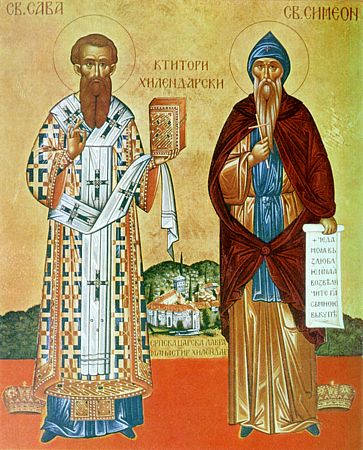 The restoration of Russo-South Slavic connections in the late fourteenth century through the monasteries of Mount Athos and Constantinople gradually led to the spread of veneration for St. Sava in Russia. Until the mid-fifteenth century, it is more appropriate to speak of the acquaintance of the educated part of Russian society (primarily the monastic community) with the veneration of this saint in his homeland and on Mount Athos. In the monthly readings of Russian Gospels and Apostles, the memory of St. Sava begins to appear (the oldest example in the parchment Gospel of St. Cyril of Belozersk at the turn of the fourteenth to fifteenth centuries), in the liturgical books, his name is mentioned (together with the name of his father, St. Simeon) in the Liturgy, in the troparia following the Psalter—troparion and kontakion to him, and in the new (verse or metric) edition of the Prologue, a short but quite substantive life is included. Over time, the number of such examples reaches to the hundreds, but all this is still evidence not of particular veneration of the Serbian saint in Russia, but rather the result of the conscientious work of Russian scribes of South Slavic originals, who worked according to the principle that, “Everything that is not explicitly prohibited is preserved.”
The restoration of Russo-South Slavic connections in the late fourteenth century through the monasteries of Mount Athos and Constantinople gradually led to the spread of veneration for St. Sava in Russia. Until the mid-fifteenth century, it is more appropriate to speak of the acquaintance of the educated part of Russian society (primarily the monastic community) with the veneration of this saint in his homeland and on Mount Athos. In the monthly readings of Russian Gospels and Apostles, the memory of St. Sava begins to appear (the oldest example in the parchment Gospel of St. Cyril of Belozersk at the turn of the fourteenth to fifteenth centuries), in the liturgical books, his name is mentioned (together with the name of his father, St. Simeon) in the Liturgy, in the troparia following the Psalter—troparion and kontakion to him, and in the new (verse or metric) edition of the Prologue, a short but quite substantive life is included. Over time, the number of such examples reaches to the hundreds, but all this is still evidence not of particular veneration of the Serbian saint in Russia, but rather the result of the conscientious work of Russian scribes of South Slavic originals, who worked according to the principle that, “Everything that is not explicitly prohibited is preserved.”
In general, the transition of the cult of a national saint to another country is an event that requires special circumstances. Even in neighboring Bulgaria and Serbia, the circle of common Slavic saints is relatively small, despite geographical proximity and close historical ties. Such a transition is usually associated with bringing the saint’s relics or their part to a new place or with a change in political borders, as a result of which the center of worship ends up in another state. St. Sava, after his death in Trnovo in 1235, almost became a Bulgarian saint: Tsar Ioann Asen II and Patriarch Ioakim did not rush to send the remains to Serbia of a man who even during his lifetime became famous for numerous miracles, and agreed to transfer the relics only after lengthy persuasions by King Vladislav. The ceremony of carrying Sava’s relics from Trnovo was sumptuous by royal standards, but until the Turkish conquest, the Serbian saint practically not venerated in Bulgaria.
The emergence of veneration for St. Sava in Muscovite Russia had a different character and was influenced by the events of its own political and Church history. In the mid-fifteenth century, Moscow scribes turned to Bulgarian and Serbian experiences of past centuries to justify the legitimacy of the autocephaly of the Russian Church. They wrote the “Story of the Bulgarian and Serbian Patriarchates,” placed as a preface to some Rudder copies and published together with it in 1652. A significant part of this text consisted of the life of Sava, notable for the fact that its author did not explicitly refer to literary sources but relied on oral traditions, possibly of Athonite origin. The creator of the independent Serbian Church is portrayed here as a young pagan who not only took monastic vows but also converted to Christianity on Mount Athos, “later converting his father and the entire country to Christianity.” Perhaps the unknown scribe was inspired by the persistent designation of Sava as the “teacher of the Serbs.” From this time, one can speak of a pronounced interest in Russia in the personality of the first Serbian archbishop. Simultaneously, the “spread in Russian Menologies of the service to the saint” occurred. It is challenging to say if one of the most prominent writers of fifteenth-century Russia, the Athonite monk and Serbian by origin, Pachomius Logofet, was somehow involved in this, but his authorship in relation to the “Story...” in the Rudder can be confidently ruled out.
By the end of the century, Muscovite Russia fully recognized itself as the heir to the entire Orthodox celebration. Other Orthodox Slavs recognized this role for Russia early on. Embassies from Athonite monasteries and descendants of Serbian despot dynasties, living in the Kingdom of Hungary, arrived to the future “Third Rome” for financial assistance—acquaintance with the veneration of St. Sava naturally occurred through both of these lines. In 1517, monk Isaiah brought to Moscow a comprehensive life of Sava, written at the turn of the thirteenth to fourteenth centuries by the monk Theodosius. In its new location, this monument gained extraordinary popularity.
We have more than eighty Russian copies of this extensive life that have survived, even in Serbian collections. In the seventeenth century, the composition was present in any significant Russian monastery library. Apparently, the fortunate combination of the saint’s fame with genuinely interesting narration played a role. However, this life was not only copied independently but also served as a source for the Russian Chronograph—a world-historical compilation created between 1516 and 1522 at the St. Joseph of Volokolamsk Monastery near Moscow, aiming to justify the historical rights of Muscovite Russia as the heir and successor of all Orthodox states.
The flourishing of the cult of St. Sava in Russia coincided with the reign of Ivan the Terrible. This was facilitated by a whimsical intertwining of many factors: the development of ideas laid down during the reign of his father, Basil III, and the veneration of Sava and Simeon as creators of the Serbian state and Church, associated with the adoption of the royal title in 1547, patronage of Athonite monasteries, and dynastic roots (through his mother, Elena Glinskaya, Ivan IV was connected to the Serbian aristocratic family of Jakšić). In the early years of the reign around 1549, Sava and Simeon of Serbia were officially canonized by the Russian Church and included in the number of “new miracle-workers” along with Russian saints. From this time, their images became common on Russian icons. A paired depiction of them in prayer was placed on the pillar of the Kremlin’s Archangel Cathedral, serving as the burial place for princes and tsars. Although there were few individual icons of these saints, they were consistently placed on the so-called “Menologia”—painted monthly calendars that spread in Russia from the mid-sixteenth century. In 1555, the images of Sts. Sava and Simeon were embroidered along with the main Russian saints and heavenly protectors of the royal family on the border of the royal doors curtain, presented by Ivan the Terrible to Hilandar Monastery. In a way, this was a response to the gift of the monastery embassy, presenting Ivan Vasilevich with a cross containing the relics worn by St. Sava.
By the end of the reign of the “Terrible Tsar,” Russian miniaturists had created illustrations for the life of St. Sava to the extent it was included in the Chronograph and became part of the famous Illustrated Chronicle Compilation of the second half of the sixteenth century. Several dozen miniatures illustrating the life exceed in volume everything that exists on this topic in medieval Serbian art. For some time, until domestic researchers had access to the frescoes of Georgy Mitrofanovich in the refectory of the Hilandar Monastery, dedicated to the life of St. Sava (29 scenes, 1621), it was even assumed that both cycles traced back to one original—a lost Life of the first Serbian archbishop. However, the difference in iconography between miniatures and murals and the complete absence of Balkan realities in the works of Russian masters indicate that the latter were quite independent.
In the 17th century, the cult of the Serbian saint had already become an integral part of Russian culture and church life.
Notes
1. State Russian Museum. Department of Ancient Russian Art. Ancient Group. No. 13.
2. For example, in the Service Book of the 1440s, probably written on the order of Novgorod Archbishop Euthymius P//RGADA. Collection of F.F. Mazurin. Op. 1. No. 539.
3. The earliest example in the so-called Psalter of Metropolitan Cyprian//OR RGB. Fundamental collection of the Moscow Spiritual Academy. No. 142.
4. The senior list is in the manuscript of 1429, copied by “a layman” Eustathius Shepel for the Trinity-Sergius Monastery/There. Collection of the Trinity-Sergius Lavra. No. 717.
5. Smirnov, S. N. Serbian Saints in Russian Manuscripts//Jubilee Collection of the Russian Archaeological Society in the Kingdom of Yugoslavia. Belgrade. 1936. P. 161-262.
6. See: Belyakova, E. V. Justification of Autocephaly in Russian Kormchi//The Church in the History of Russia. M. 2000. Collection 4. P. 139-161.
7. See: Turilov, A. A. South Slavic Monuments in the Literature and Manuscripts of Lithuania and Moscow Russia in the 15th-first half of the 16th centuries//Slavic Almanac 2000. M. 2001. P. 258.
8. In the edition of J. Danicic (Theodosius of Hilandar. Life of St. Sava. Belgrade. 1973), the typeset text occupies 221 pages of regular format. See also: Gavryushina, L. Another Russian edition of the Life of St. Sava of Serbia//Archaeographic supplements. Belgrade. 2000-2001. Book 22/23. P. 445. The number of Serbian copies of the monument is several times less.
9. See: Smirnova, E. Katapetasma of 1555: On the Iconographic Program of Border Decoration//Eight Centuries of Hilandar. Belgrade. 2000. P. 495–500.
10. RORNB. P. IV. 233 (so-called Laptsevsky volume).

